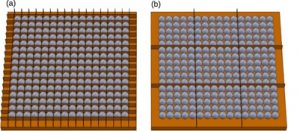Directed Particle Self-Assembly
The spatial arrangement of nanostructures tailors the electrical, magnetic or photonic as well as other properties of the material. The directed self-assembly process, by controlling the particle interactions, controls the formation certain structure. A graphoepitaxical method, where particles are deposited onto a pre-patterned substrate to form a monolayer, has shown that the pattern geometry and the dimensions of patterned templates on the substrates has an effect on the ordering of monodispersed particles. This indicates the very positive potential that by varying the patterned templates, particle assembly can favor a metastable structure other than the hexagonally close-packed lattice that is favored to form on a pattern-free substrate. This type of assembly has been proved to be successful with the assembly of block copolymers. The simulation result has shown that a periodic square template disrupts the formation of hcp lattice in favor of a square lattice. More important, this square template can have dimensions up to at least 10 times the particle diameter and still directs particles to form the same square lattice. This illustrates that with graphoepitaxy, particles can be directed to self-assemble into a desired pattern with the help of a relatively large pre-patterned template.


